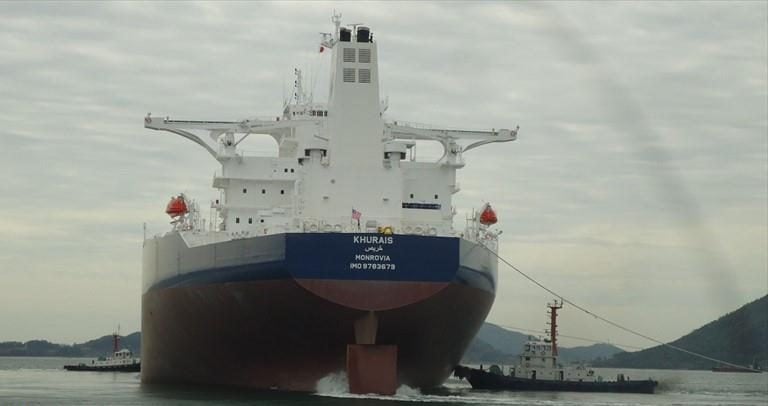10 tankers loaded with 20 million barrels of Saudi oil continue to gather off the coast of the Egyptian city of Suez, in a remarkable scene that raises many questions about the reasons for this crowd of tankers.
The reasons for the presence of these large quantities of oil barrels coming from Saudi Arabia and anchored off the Ain Sukhna region in Egypt are not yet clear, according to what was published by Bloomberg Agency, on Saturday, June 17, 2023.
There are estimates indicating that the mobilization of 20 million barrels of Saudi oil in this region is attributed to the preparation for its transfer to Europe due to the high demand for Saudi crude in the old continent, according to what was seen by the specialized energy platform.
What happened?
Data from the analytics company Vortexa showed that 20 million barrels of Saudi oil are being accumulated off the coast of the Red Sea in Egypt.
The company said that these floating tankers, on which Saudi crude is loaded, are the largest since the Corona pandemic crisis in 2020.
The following map, prepared by the specialized energy platform, monitors the locations of Saudi oil tankers stationed on the Egyptian coast, until the evening of Sunday, June 19:
“The last time the volume of crude stocks on Saudi floating oil tankers – at levels higher than the quantities currently in place – was in the second quarter of 2020,” says Guy Maro, head of market information and analysis at Vortexa.
He added, “At that time, the stock levels of floating oil tankers reached 30 million barrels, but that was amid a broader increase in floating storage vessels, and the market data was different.”
It appears that 8 of the 10 ships moored off Ain Sukhna are owned by Saudi Arabia, according to ship-tracking data monitored by Bloomberg, and they are ships that carry 20 million barrels of Saudi oil.
What’s the reason?
It seems that the reasons for the presence of 20 million barrels of Saudi oil on board these tankers are unclear, at a time when Saudi Arabia pledged to make additional production cuts after the decision of the OPEC + coalition to voluntarily reduce production.
The analyst at Forzetica, Guy Maro, explained that one of the possible explanations for the presence of these quantities of Saudi crude in the region may be due to the high demand for Saudi crude in Europe, as it paves the way for the transfer of these quantities to the European market, ruling out that infrastructure problems are the reason behind this. practices.
In this context, it should be noted that there are significant concerns globally about the oversupply of oil, and investors are trying to gauge the direction of demand growth, particularly in China.
Other floating Saudi oil tankers are still arriving at the Ain Sukhna oil port on the Red Sea in Egypt, and are continuously unloading shipments.
The following map shows the path of transporting oil shipments through the Sumed pipeline:
 It should be noted that Ain Sukhna is the starting point for the Sumed pipeline, which extends to the crude oil storage and loading terminal at Sidi Kerir on Egypt’s Mediterranean coast, through which crude can be transported to Europe.
It should be noted that Ain Sukhna is the starting point for the Sumed pipeline, which extends to the crude oil storage and loading terminal at Sidi Kerir on Egypt’s Mediterranean coast, through which crude can be transported to Europe.
It is also worth noting that the Egyptian oil refining facilities are partially owned by a number of Middle Eastern oil-producing countries, including Saudi Arabia, which is the largest user of Egypt’s oil infrastructure.
The names of the carriers and their cargo
Ten VLCC supertankers, loaded with about 20 million barrels of Saudi oil, settled off Ain Sukhna, at the entrance to the Egyptian Suez Canal.
To clarify the path of the tankers, it is indicated that they stop in Ain Sukhna to unload part of the shipments through the Sumed pipeline, which extends to the storage and loading station at Sidi Kerir station in the Mediterranean.
Analysts asked about the cost of the continued presence of tankers loaded with nearly 20 million barrels of Saudi oil in Ain Sukhna, in addition to the storage capacity at Sidi Kerir station, which can accommodate about 30 tanks, equivalent to 21 million barrels.
This leads to the possibility of the tankers stationed in Ain Sukhna breaking down, if storage levels at the station reach high levels.
Below, the specialized energy platform publishes the names of the 10 tankers loaded with about 20 million barrels of Saudi oil, the volume of each of them and the quality of the crude, according to Kepler data:
- The Arsan tanker carries 2.11 million barrels of Arab Light crude.
- The Haradh tanker carries 2 million barrels of Arab Light crude.
- Khurais tanker carries 2 million barrels of Arab Light crude.
- The tanker “Laila” carries 2.12 million barrels of Arab Light crude.
- The tanker “Lulu” carries 2.11 million barrels of Arab Light crude.
- Tanker “Maniva” carrying 2 million barrels of Arab Light crude.
- The tanker “Newton” carries 2 million barrels of Arab Medium crude.
- The Noble tanker carries 2 million barrels of Arab Extra Light crude.
- The Samaha tanker carries 2 million barrels of Arab Light crude.
- The tanker, Warfa, carries 2.12 million barrels of Arab Light crude.
*This report was last updated on Sunday, June 18, 2023.

Leave a Reply